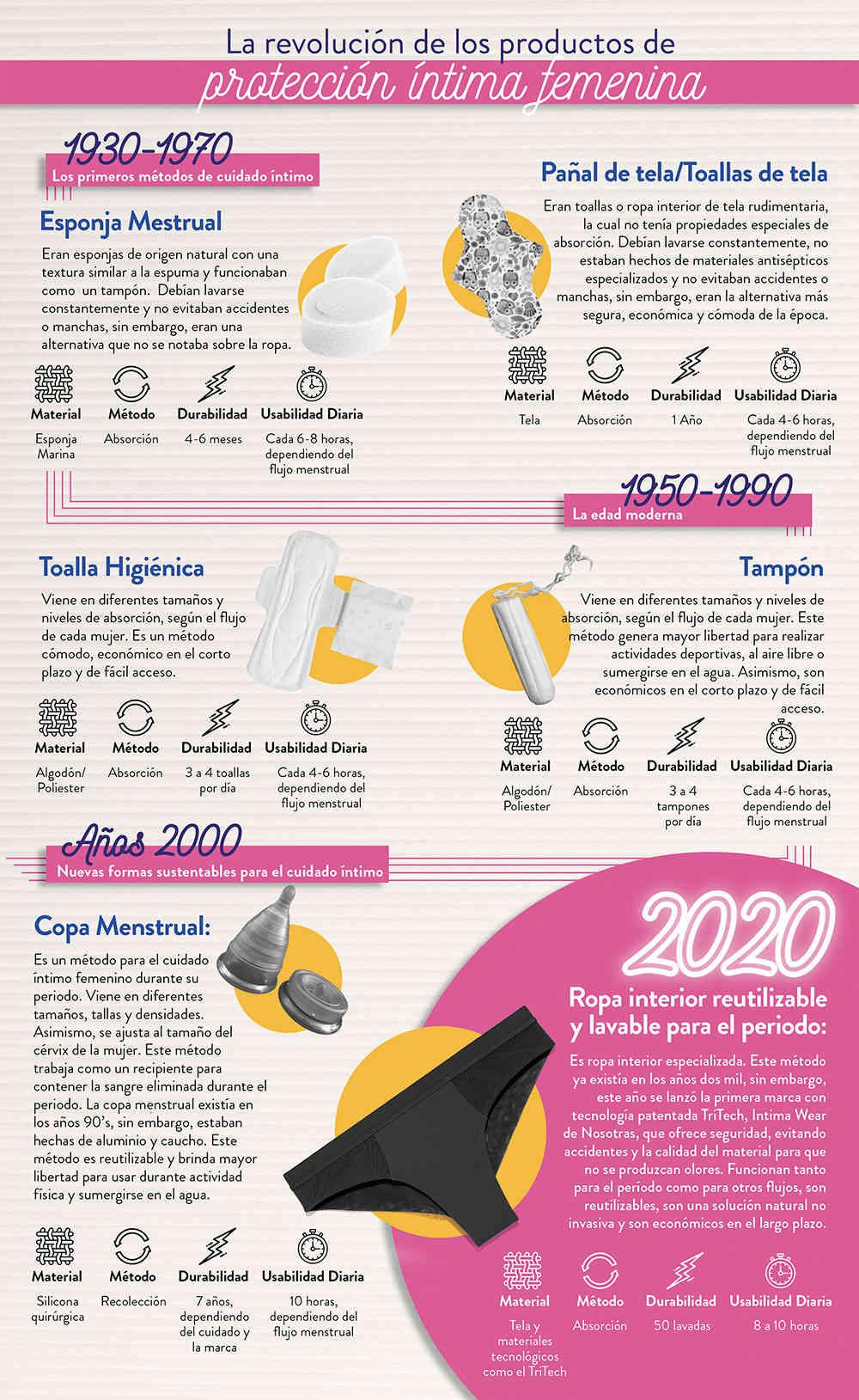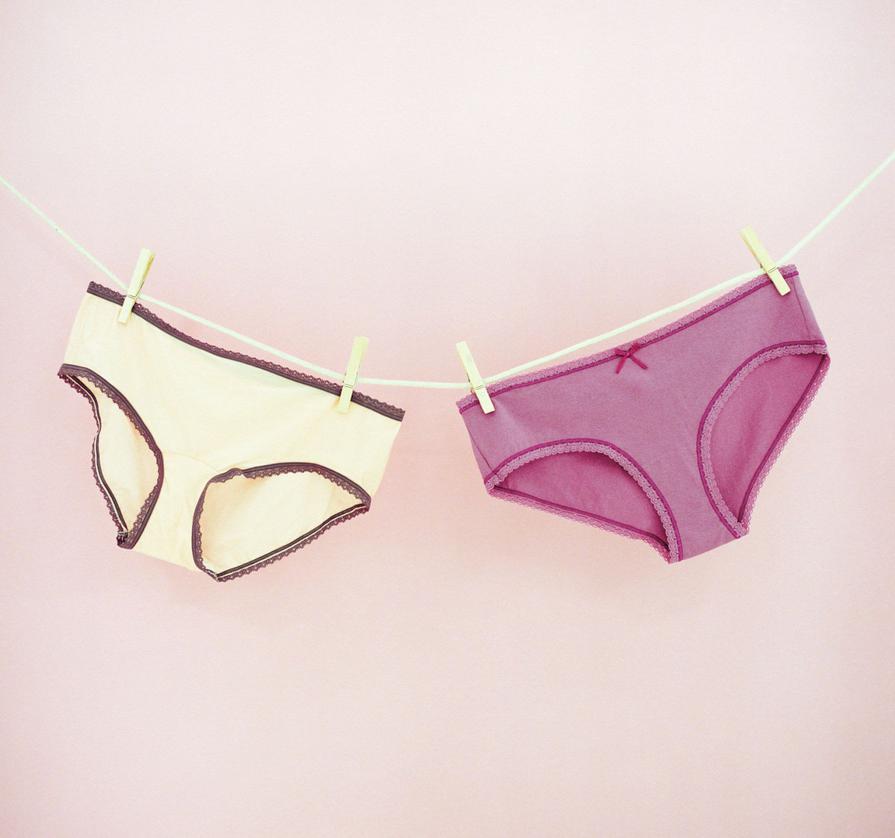The new hygiene alternatives for the menstrual period have been the answer to several problems. First, the environmental impact generated by pads and tampons. Towels alone take approximately 500 years to decompose because they are not made from biodegradable materials. According to UN figures, women who use sanitary napkins generate an average of 60 kilograms of waste from this article during their lives, which is equivalent to 100,000 tons of waste per year. On the other hand, there are girls in rural areas and developing countries who do not have access to sanitary products when they menstruate and this generates, for example, school absenteeism because they feel ashamed of their bodies.
According to figures from the ANDI Chamber of the Cosmetic and Grooming Industry, in 2019 the market size of the cosmetic, grooming and absorbent sector was US$5,255.9 million, while in 2018 it represented US$5,045.8 million. In the absorbent subcategory, sanitary protection had a 28% share with US$242.7 million.
On the other hand, between March and June 2020, the pandemic and the quarantines caused by COVID-19 caused Colombian households to make hoarding and supply purchases due to fear and uncertainty due to a possible shortage of some products. According to Raddar, a firm specialized in consumption, although this behavior was left aside, "Colombians have reorganized their priorities and have attributed greater importance to certain needs related to personal hygiene, in order to minimize the possibility of catching the virus. ”.
Thus, during 2020 the consumption of articles for body hygiene has had an atypical behavior, since it went "from an annual growth in volumes that was around 6.5% in 2019 to a variation of more than 24% during the months of March , April and June of this year. However, in recent months, a stabilization of spending in this category has been seen, reaching a year-on-year increase of 8.04% in September”, reads a document from the firm.
For their part, sanitary napkins, which make up 24% of the category of articles for body hygiene, have not been immune to these changes, as they have presented an "excellent performance in recent months". However, Raddar explains, it should be taken into account that the slowdown in inflation for this product, which went from 3.50% in September 2019 to 1.92% in the same month this year, could also encourage spending. .
According to the Raddar Consumer Track, the brands of sanitary napkins most purchased by Colombian households are Nosotras and Kotex, with television being the advertising medium most remembered by consumers. It can also be concluded that during 2020 the main purchase channels most used to acquire these products have been neighborhood stores, followed by supermarkets. For a few years there has been a boom for sustainability in fashion, food and, also, in menstrual protection. Start-ups, and now big brands, have launched menstrual cups and absorbent panties on the market to respond to these needs.
The consumer firm explains that although the behavior of towels has been good in recent months, "the growing trend of caring for the environment and the entry into the market of new competing products, such as menstrual cups and absorbent panties, from both small and large brands, they can affect the cost of sanitary napkins in the future”.
the tights
When the commercial for reusable pantyhose hit national television channels, many women began to wonder how they worked and if they were really going to be protected from staining during their menstrual period. Others celebrated on social networks Nosotras' decision to launch another alternative on the market that, in addition to being innovative, would contribute to the environment.
Nosotras, a brand that has been in the Colombian market for 45 years and is part of Grupo Familia, began creating pantyhose three years ago with the help of the Swedish company Essity. “We are a multi-layer brand that understands that there are many alternatives in the market for the client. And this pantyhose was the one we chose to serve those consumers who want to contribute to the environment and feel free during their period. As far as research and tests have been carried out, we have had good acceptance”, says Carolina Restrepo, director of brand development for Grupo Familia.

The reusable and washable pantyhose have a patented technology called Tritech Performance, with three layers that allow the interior to absorb, retain flow, control odors and be breathable. Menstrual panties have reinforced edges and last 8 to 10 hours. They should be washed in the shower with water to remove the blood and then they can be put in the washing machine. They have a useful life similar to that of an ordinary garment. According to the brand, using an Intima Wear interior is equivalent to using two invisible towels and they work for light or moderate flow. The pants went on sale in the virtual store that the company had. By 2021 they hope to market them in different physical channels. “The digital platform was a challenge for us. We are focused on driving a new product on a new platform.”
For now, Restrepo rules out the company entering the menstrual cup market, "we are going to focus on pantyhose." In addition to menstrual pads, the company, which has a portfolio that includes sanitary napkins, panty liners and intimate soaps, is working on projects to reduce the consumption of materials in tampons. According to their own figures, between January and September 2019 they saved 176 tons of packaging material.
Other ventures
Somos Martina is a venture that Juliana Villegas launched on the market on March 8, 2019, coinciding with the celebration of Women's Day and that focuses on manufacturing menstrual interiors. To create these, it took two and a half years to develop the fabric and get the suppliers to make them in Bogotá. They are made with cotton and have three layers of material.
“They have a technology similar to stay dry exercise clothes, so that women won't feel damp. We have them available in three models: cheeky or cheeky for light flow, boxer for medium flow and super absorbent for heavy bleeding and ideal for postpartum”, says sociologist Villegas, who emphasized gender studies and a postgraduate degree in Fashion Management, and wanted to unite fashion with gender issues.
“The cup seems like a cool invention to me, but it wasn't for me. Four years ago in New York I found out about menstrual underwear and wanted to create a Colombian brand, but at that time the sustainable menstruation boom was not yet there. Two years ago I saw that the cup became fashionable and I said: 'It's time'”.
Regarding the launch of Nosotras, Villegas says that she was scared, but on the contrary, advertising in the mass media and on social networks of a traditional brand makes people trust the garment. "The arrival benefited me, because many people in networks began to show that my business already existed and brought me many clients." In addition, Somos Martina has pants for abundant flows and its price is cheaper.
The venture also seeks to educate women and break the taboos that still persist about the period. "Through the Instagram account I do live broadcasts with gynecologists to answer questions, I have made donations and the idea is to generate a social impact." It's called Somos Martina because Villegas "wanted a woman's name that was in all languages," so he was inspired by Martinas who have made history, such as the Colombian actress Martina García, the Chilean Martina Barros Borgoña, the Argentine Martina Chapanay, among other.
The enterprise exports to Spain, Norway and the United Kingdom. Although the pandemic limited his expansion plan in Latin America, it also helped him boost entrepreneurship. “Before the quarantine, many women wrote to me, but they were afraid of getting dirty in the office. Locked-up women dared to try it and sales tripled for me. With the panties, women become aware of the impact we generate with the environment”.
Be Girl Latin America is an initiative that industrial designer Diana Sierra created in 2011, when she traveled to Uganda to carry out projects involving the installation of solar panels. During that time, working with girls and women, she realized the problem they had in accessing sanitary products, so she made the first prototypes of reusable sanitary pads so that they could understand their menstrual cycle. In 2014, Sierra launched Be Girl as a social enterprise.
Also read: The Colombian designer who revolutionized menstruation in Africa
“The goal is to change the way we see menstruation. On a global scale we perceive it as something shameful. What we want is to change that stigma conversation for something nice to celebrate. We want a world where access to opportunities is based on merit and not on gender”.
Among her portfolio are panties for menstruation, washable pads and menstrual cups. “They are products for the sustainable management of menstruation, because it is important to provide options, since not everyone manages the body in the same way and girls must have the possibility of choosing the products that best suit their culture, their resources and its environment”, explains Sierra, co-founder and director of Be Girl.
Isis Tijaro is the owner of Agua Cup, a brand of menstrual cups that offers three types of sizes and has been on the market since 2017. The cup is a bell-shaped device that is inserted into the vagina and has the function of collecting menstrual bleeding during the period. The device is reusable, has a useful life of eight to 10 years and is made of TPE, a medicinal thermoplastic, a class of polymer that is easy to use and manufacture. Before and after the menstrual cycle, the cup must be sterilized for five minutes in hot water in a stainless steel container or in a collapsible silicone cup that can be placed in the microwave. Menstrual cups, unlike tampons, do not absorb and allow fluids to be regulated.
“In Latin America, the adoption of the cup is easier because the market is better developed. In Colombia there are thong-type protectors, with cotton, with many attributes that you don't see in other markets. I think that with a good investment in campaigns that not only educate you on the environmental impact, but also on the physical part, it would be very profitable”, adds Sierra.
Read: Menstrual cup: use, advantages and disadvantages
In addition, they are cheap, but the savings are in the long term. The price of a cup ranges between $70,000 and $100,000 and that of a reusable underpants between $60,000 and $100,000. In contrast, a 10-pack of towels can cost $5,000 and must be changed every three to four hours. During a 5-day period, a woman would spend around 30 pads. That is, a year she would spend approximately $180,000.
Tijaro says that the market offers new alternatives to absorb or collect menstrual blood such as cups, menstrual underwear, free bleeding or sea sponges. “There is also a boom in humanitarian aid and social programs in which menstruation is occupying a very important place. However, all this has two faces. On the one hand, the claim, the fight for menstrual rights and for women to be more autonomous. On the other hand, menstruation becomes a control mechanism”.
The anthropologist Isis Tijaro explains that the donation of massive cups has to be viewed with a magnifying glass, since it must be done ethically and responsibly, since not all women have access to drinking water to sterilize it. On the other hand, the boom has caused many brands to come onto the market that do not have the right materials and are not regulated by Invima.
“My brand is legally distributed in Colombia. We pay VAT, certified materials and I have received positive feedback from women. Since January I have been in a piloting phase to launch the menstrual panties”.
The fight to remove VAT from the menstrual cup
With the tax reform of 2016, sanitary napkins and tampons were taxed with a VAT of 16%. The Tax-Free Menstruation initiative of the Gender and Economic Justice Group of the Network for Tax Justice managed to reduce VAT to 5% and, finally, with Judgment C-117, the value-added tax was removed and the items were considered First need. However, the menstrual cup was taxed at 19%.
In the fight against the "pink tax", as the VAT charged on toiletries or women's clothing was called, the Colombia Menstrual Rights collective requested in 2018, through citizen intervention, the exemption from the tax on the cup menstrual.
It may interest you: The Constitutional Court studies whether to leave the menstrual cup without VAT
The Constitutional Court said that since it was a "luxury good" it did not have to be exempt and that it was not part of the basic basket. “In February 2020, the Court receives another lawsuit for the unconstitutionality of the tax on menstrual cups. Another window was opened for people to participate in order to guarantee menstrual rights in our country and eliminate this sexist and elitist tax. We hope for a positive response," said a spokeswoman for the group, which was formed in 2018 with the aim of creating an agenda for menstrual rights in Colombia.
"The tax deepens inequalities in girls, women and menstruating people, since it limits access to products that could provide more dignified, healthy, environmentally and economically sustainable menstruation," explains the group, which after the lawsuit resumed the Copa sin VAT.
Diana Sierra points out that “menstruating is not a decision. It is a biological cycle. It is quite unfair that we have to pay taxes for products of basic necessity. Access to menstruation products should be considered essential, including cups. That would help make them accessible.”
Finally, Tijaro says that there are advances in tax justice, education and menstrual rights in the country. However, it is necessary not to stigmatize menstruation, since women are not the ones who pollute the planet. “Those who pollute are the brands that produce the articles. We must analyze what are the narratives that are being established in the discourse of menstruation”.


